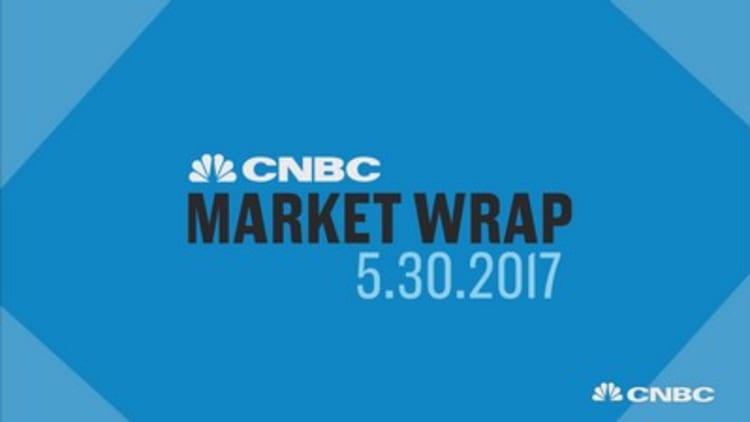
U.S. equities closed lower on Tuesday as investors digested key economic data, but a rise in tech stocks helped cap losses.
The Dow Jones industrial average fell about 50 points, with Goldman Sachs contributing the most losses.
The Nasdaq composite traded 0.1 percent despite shares of Amazon breaking above $1,000 for the first time. The S&P 500 slipped 0.1, with energy leading decliners, but the information technology sector rose 0.31 percent. Tech has been on fire this year, rising around 20 percent. Nevertheless, the Nasdaq and S&P snapped a seven-day winning streak.
"The large tech outperformance is a trend I wouldn't fight right now," said Mark Heppenstall, CIO at Penn Mutual Asset Management, but noted, "there's a lot of good news priced into these stocks."
U.S. stock markets were closed Monday because of the Memorial Day holiday.
Personal income rose 0.4 percent in April, in line with expectations, and consumer spending increased by 0.4 percent. The personal consumption expenditures price index, the Federal Reserve's preferred measure of inflation, rose 0.2 percent.
"The series stubbornly has not risen to anywhere near the FOMC's preferred level of inflation. Despite ostensibly failing to satisfy half of its Dual Mandate, the central bank will have few problems progressing down the path to normalization," said Jeremy Klein, chief market strategist at FBN Securities.
Meanwhile, U.S. home prices rose 5.8 percent in March, according to the S&P/Case-Shiller U.S. National Home Price Index.
Other data released Tuesday include consumer confidence reading for May, which came in at 117.9, slightly below a consensus estimate of 119.
"The economic data support the narrative that we have a solid fundamental backdrop," said Art Hogan, chief market strategist at Wunderlich Securities. "What we need here is progress on the [Trump] agenda."
President Donald Trump returned from his first trip overseas to deal with the fallout from reports that Jared Kushner, his son-in-law and a top adviser, discussed the potential to set up a "secret and secure communications channel" between the Trump transition team and the Kremlin.
Stocks came into Tuesday's session having posted strong gains in the previous week. Those gains propelled the S&P and Nasdaq indexes to record levels.
"What's driving the market here is the fact that interest rates have been so low lately," said Bruce Bittles, chief investment strategist at Baird. "Everyone thought interest rates were going up but the opposite has happened."
The benchmark 10-year note yield began 2017 trading near 2.5 percent but hovered near 2.22 percent on Tuesday.
Dallas Fed President Robert Kaplan told CNBC on Tuesday he sees U.S. growth to remain near 2 percent and not the 3 percent or more forecast by President Donald Trump's administration.
"Two things drive GDP: growth in the labor force and growth in productivity," he said in a live interview on "Squawk Box." "The problem is labor force growth is very sluggish. And my own judgment and our economists at the Dallas Fed think it's going to continue to be sluggish the next 10 years because the population is aging and labor force growth therefore is slowing."
Major U.S. Indexes
The Dow Jones industrial average fell 50.81 points, or 0.24 percent, to close at 21,029.47, with Goldman Sachs leading decliners and Verizon outperforming.
The slipped 2.91 points, or 0.12 percent, to end at 2,412.91, with energy leading seven sectors lower and telecommunications the biggest advancer.
The Nasdaq declined 7 points, or 0.11 percent, to close at 6,203.19.
About nine stocks declined for every five advancers at the New York Stock Exchange, with an exchange volume of 770.36 million and a composite volume of 3.186 billion at the close.
The CBOE Volatility Index (VIX), widely considered the best gauge of fear in the market, traded near 10.4.
—CNBC's Jeff Cox contributed to this report.
On tap this week:
What to Watch
Wednesday
Earnings: Michael Kors, J. Jill, Hewlett Packard Enterprises, Palo Alto Networks, Box, Vera Bradley, Analog Devices
8:00 a.m. Dallas Fed President Rob Kaplan
9:45 a.m. Chicago PMI
10:00 a.m. Pending home sales
2:00 p.m. Beige book
7:30 p.m. San Francisco Fed President John Williams
Thursday
May vehicle sales
Earnings: Dollar General, Lululemon Athletica, VMWare, Broadcom, Workday, Five Below, Yext, Cooper Cos, Express, Ciena, Mobileye
8:15 a.m. ADP employment
8:30 a.m. Initial claims
8:30 a.m. Productivity and costs
9:45 a.m. Manufacturing PMI
10:00 a.m. ISM manufacturing
10:00 a.m. Construction spending
Friday
Earnings: Hovnanian
8:30 a.m. Employment
8:30 a.m. International trade


